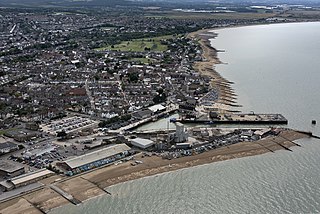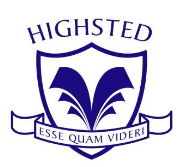
Whitstable is a town in the Canterbury district, on the north coast of Kent adjoining the convergence of the Swale Estuary and the Greater Thames Estuary in southeastern England, five miles north of Canterbury and two miles west of Herne Bay. The 2011 Census reported a population of 32,100.

Sturry is a village on the Great Stour river situated 3 miles (4.8 km) northeast of Canterbury in Kent. Its large civil parish incorporates several hamlets and, until April 2019, the former mining village of Hersden.

A secondary modern school is a type of secondary school that existed throughout England, Wales and Northern Ireland from 1944 until the 1970s under the Tripartite System. Schools of this type continue in Northern Ireland, where they are usually referred to as secondary schools, and in areas of England, such as Buckinghamshire, Lincolnshire and Wirral,.
The grammar schools debate is a debate about the advantages and disadvantages of the existence of grammar schools in the United Kingdom. Grammar schools are state schools which select their pupils on the basis of academic ability, with pupils sitting an exam in the last year of primary school to determine whether or not they gain a place. The debate on selective education has been widened by measures which allow a proportion of students to be chosen based on their "aptitude" for a particular subject.
Lincolnshire is one of the few counties within the UK that still uses the eleven-plus to decide who may attend grammar school, in common with Buckinghamshire and Kent.

The Henrietta Barnett School is a grammar school with academy status for girls, in Hampstead Garden Suburb in London. The Good Schools Guide called the school 'One of the best academic state schools in the country, providing a gentle, inspiring education in a wonderful setting for very clever girls', and the school consistently ranks amongst the top state schools in educational league tables. The school was named among the 'magnificent seven' in 2005, following three mentions as being 'outstanding' in Ofsted's inspections. Following its latest Ofsted inspection in May 2022, the school was recategorised as "Good".

Harrogate High School is a comprehensive secondary school in Harrogate, North Yorkshire, England. It has about 720 pupils on roll and approximately 85 full-time teaching staff. The school was awarded specialist Sports College status. The Academy Head is Sukhraj Gill.
Jubilee High School is a coeducational secondary school with academy status, located in Addlestone, Surrey, England. The school holds Artsmark Gold Award and International School status.

Herne Bay High School is a mixed ability Academy, with designated Sports College status, situated in Herne Bay, Kent, England. There are 1506 students in the school aged 11 to 18. The principal as of March 2022 is Mr Jon Boyes.
Pensnett High School was a secondary school located in the Pensnett area of the Dudley Metropolitan Borough, in the West Midlands of England. There were around 150 pupils aged 14–16 on the school roll before closure.

Darrick Wood School is a mixed secondary school in Orpington, London Borough of Bromley, United Kingdom with a current roll of 1785 pupils. It was first opened in 1975.
Wombourne High School is a coeducational secondary school and sixth form located in Wombourne, Staffordshire, England. It is situated on Ounsdale Road in the west of the village, and stands on an adjacent site to the local leisure centre. In addition to its main function as a secondary school, Wombourne High School has a standalone building dedicated to its sixth form, which was opened by the pop star Beverley Knight.

The Canterbury Academy is a co-educational 11-19 academy school in Canterbury, Kent, England. It is a specialist Sports College and 15% of its 1081 pupils are selected on musical aptitude. The school was founded as a non-selective secondary modern foundation school before gaining academy status in 2010.

Fulston Manor School is a secondary School with academy status in Sittingbourne, Kent. The head teacher is Mrs Susie Burden. It teaches years 7–13.
The Lenham School is a coeducational secondary school and sixth form located in Lenham, Kent, England. It opened in 1952, as Swadelands School, and provides a secondary education for 788 boys and girls aged 11 to 18 years.

Highsted Grammar School is a state-funded selective secondary school for girls in Sittingbourne, Kent.
The Dover Christ Church Academy, previously known as Archers Court Secondary School is a coeducational secondary school and sixth form located in Whitfield, Kent, 4 miles north of Dover.
The Spires Academy is a non-selective secondary school for pupils aged 11–16 in Canterbury, Kent. There is a sixth form. The school has dual specialist status in business and enterprise, and in visual, creative and performing arts. Spires is independently governed, but funded by the sponsors and the Department for Children, Schools and Families. As a non-selective school the school does not insist on prospective pupils passing the eleven-plus examination for entry, and it is free to attend. The Academy is subject, like other schools, to regular inspections, but is managed by an ‘Academy Trust’ called E21C, rather than a local education authority. According to Ofsted inspectors, boys do worse at maths at the school, and generally the school needs to improve (academically).

The Charles Dickens School is a co-educational secondary modern school located in Broadstairs in the English county of Kent. The school is named after Charles Dickens, the 19th-century writer and social critic. It is one of six non-selective schools on the Isle of Thanet, physically isolated corner of Kent.
St Edmund's Catholic School is a co-educational Roman Catholic secondary school located in Dover, Kent, England. The school is named after Edmund of Abingdon, and is under the jurisdiction of the Roman Catholic Archdiocese of Southwark.











